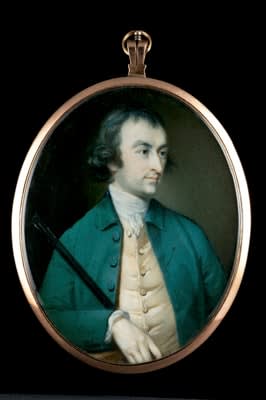
Richard Crosse
Portrait miniature of Thomas Snape of Alsager, c. 1770
Watercolour
Oval, 76mm high
Philip Mould & Co.
To view all current artworks for sale visit philipmould.com This portrait of Thomas Snape is one of Crosse’s most impressive portrait miniatures. As one of the first exponents of...
To view all current artworks for sale visit philipmould.com
This portrait of Thomas Snape is one of Crosse’s most impressive portrait miniatures. As one of the first exponents of watercolour on ivory, Crosse more usually painted on small pieces of the new support. By definition his work normally falls into the category of the ‘Modest School’, but there are a few rare examples of him painting on this scale. This larger portrait, which is most unusual in that it includes a musket held under Alsager’s arm, reveals the possible influence of Crosse’s contemporaries working in oil both in its ambitious size and composition. It displays the artist’s extraordinary ability to convey fabric texture, as well as minute facial details, in watercolour.
Crosse was born a deaf mute and initially took up miniature painting as an interested amateur. His talent soon became apparent and he won a premium at the Society of Arts in 1758, going on to study at Shipley’s Drawing School. His clientele included the royal family, as well as aristocratic sitters. He also painted many portraits of his own family, including his brother who cared for him.
This portrait of Thomas Snape is one of Crosse’s most impressive portrait miniatures. As one of the first exponents of watercolour on ivory, Crosse more usually painted on small pieces of the new support. By definition his work normally falls into the category of the ‘Modest School’, but there are a few rare examples of him painting on this scale. This larger portrait, which is most unusual in that it includes a musket held under Alsager’s arm, reveals the possible influence of Crosse’s contemporaries working in oil both in its ambitious size and composition. It displays the artist’s extraordinary ability to convey fabric texture, as well as minute facial details, in watercolour.
Crosse was born a deaf mute and initially took up miniature painting as an interested amateur. His talent soon became apparent and he won a premium at the Society of Arts in 1758, going on to study at Shipley’s Drawing School. His clientele included the royal family, as well as aristocratic sitters. He also painted many portraits of his own family, including his brother who cared for him.